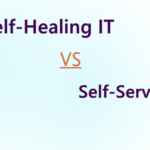What is Change and Release Management?
Change management is the business practice that aims to minimize the impact on changes of service quality. It handles planning, authorizing, overseeing the implementation of changes to services and supporting infrastructure.
Release management is the business practice that aims to protect the existing services and the supporting infrastructure during the introduction of changes. It is responsible for planning scheduling and controlling the build, test and rollout of service releases.
Change and release management are essential for keeping IT under control. It is also essential to ensure that all changes are properly documented, understood and approved before being implemented. Moreover, not all changes require a formal release. This implies, that smaller or lower risk changes can be implemented directly, but with the same discipline.
Apart from this, release management ensures smooth transition to production. It provides version control, user acceptance testing, roll out planning and organized deployment and minimizes the impact of changes on IT clients.
Change and release management work closely together to introduce changes to the IT environment. A single release can handle many changes and releases need to be performed as per a pre-defined schedule (major or minor).
ITIL Change management
Change management allows for the transition of emerging technology and processes. Change can correct misalignments, bugs and flaws, within the enterprise. While IT changes could be IT flaw fixes, bug resolution, general technological issues, etc. change management incorporates – corporation changes, IT related changes, changes in processes and changes in controls. Following are the types of changes:
- Mission and strategy
- Organizational structure
- People
- Culture
- Policies and legal agreements
- Processes
- Technologies
- Product updates
Change management is necessary when a service is about to become unavailable or degraded due to service hours. It is also essential when the functionality of a service is to become different. Change management is important when the CMDB requires an update.
In change management one can create or log request for change by providing details of contact information for those involved, why the change is happening and what will happen should it not get approved, how the change is going to be implemented, risk assessment, backup plan, people impacted, systems affected, etc.
The next step is reviewing request for change after the change is sent to approvers. A discussion is followed by either approval, requirement of more information or rejection of change request. Evaluation of change is also essential and is done based on practicality and priority. During evaluation questions like – has the change been done before? What is the impact of change and ROI? When is the best time to implement change, are asked.
To implement change the build, trust, deploy policy is used. After build and test, change manager is notified so they can coordinate deployment. The change manager communicates the changes and their impacts to stakeholders. The change manager takes into account the outages or deviations in availability in scheduling when to rollout the changes.
The next step includes reviewing and closing a change request. This includes:
- Reviewing records to determine whether the change was successful or failed.
- Recording details about the time and expense of the change to determine the accuracy of estimates that were made before a request was fulfilled.
During the change management process, a change initiator identifies the requirement for change. A change coordinator analyses request and a change manager manages request. While a change advisory board authorizes request, an approver approves request and a specialist processes request.
Some of the Key Performance indicators (KPI) for change management include:
- Successful changes: Comparison of the number of completed change to the number of successful changes.
- Backlog Changes: All changes that have not yet been completed
- Emergency changes: Total number of changes made on an emergency bases.
ITIL Release management
Release management aims to build, trust and deliver services to the customer specified by service design. The goal of release management is to deploy releases, into operation and establish effective use of the service in order to deliver value to the customer. Release management ensures that handover to service operations is done and that suitable training and documentation exists to ensure ongoing support to the new service.
The benefits of release management are following:
- New or changes service is delivered at optimum speed while minimizing risk
- Customers or users use the new or changes service in support of the business goals
- Implementation is consistent across the business, service teams, suppliers, customers
- Auditable, traceable and agreeable requirements throughout the service transition
The primary interfaces of release management exists with the change management and the surrounding service transition processes. Other inputs will also be provided from service strategy and service design to ensure that the requirements for value provision have been met.
These inputs include:
- Authorized requests for change (RFC)
- Service packages
- Service design packages
- Service acceptance criteria
- Service management policies and standards
- Build models and plans
- Exit and entry criteria for each stage of release
Outputs of a release include:
- Release and deployment plan
- Updated RFCs for any required activity
- Updated service catalogue reflecting any service changes
- New or modified service
- New or modified processes
- Skilled and acknowledgeable support staff
- End users with capabilities to use the service
- SLAs (Service level agreements), OLAs (Operational level agreements), UCs (Underpinning contract)
- Deployment plans and packages
- Deployment report
The purpose and objective of release management is as follows:
- Release management plans are defined and agreed upon by customers and stakeholders
- Release consists of a set of related assets and service components that are compatible with each other
- Integrity of a release and its constituent components is maintained throughout the transition activities and recorded accurately in the configuration management system
- All release and deployment packages can be tracked, installed, tested, verified, and uninstalled or backed out if needed
- Change is managed during the release and deployment activity
- Deviations, risks, issues related to the service are recorded with necessary corrective actions
- Knowledge transfer to enable the customers and users to use the service to support their business activities
- Ensure that skills and knowledge are transferred to operations and support staff.
Scope of release management includes the processes, systems and functions, to package, build, test, and deploy a release into operations. The release process commences with receipt of an approved request for change to deploy a production ready release package.
The performance metrics involved in tracking release management are:
- Number of incidents by back out
- Number of accurate and timely release at remote sites
- Number of unused software that have unnecessary costs
- Number of times unauthorized software is used
- Number of times CMDB status is updated/not updated
The release manager coordinates the implementation of the process with other teams:
- Prepares release plans
- Authorizes release build and configuration
- Communicates release to other groups
- Coordinated final implementation of release
To learn more about Mirat.ai’s IT Infrastructure Management Request for Trial/Demo. MIRAT’s IT change management module is Affordable & Easy to use! Get your Dashboard ready in only 5 Minutes. Contact us now!
Contact Information:
Hema
Sales Executive
Phone: +1-315-636-4213
Email: sales@mirat.ai
Website: https://www.mirat.ai/


